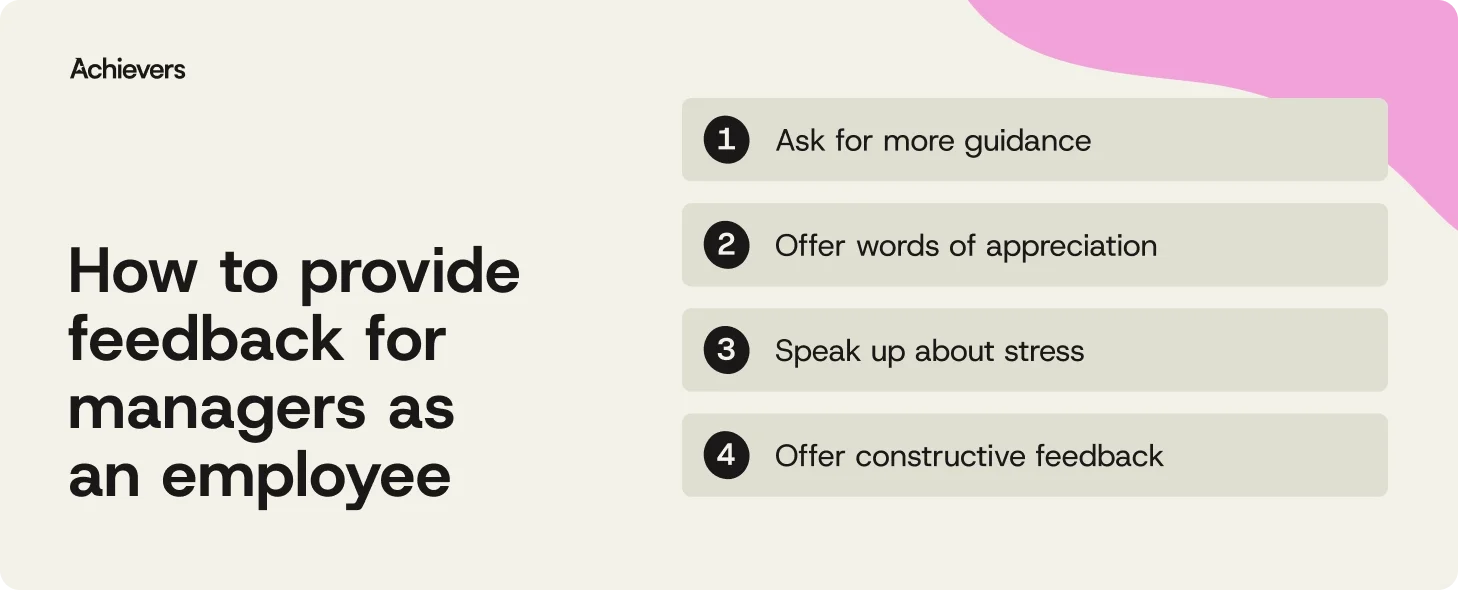Table of contents
Create a culture that means business™
Schedule a demo with an Achievers solution expert today.
Let’s be honest — feedback usually flows one way. Managers give it. Employees get it. End of story.
But when feedback only moves top-down, you miss a major opportunity to strengthen your company’s culture, leadership, and results. The best workplaces don’t just give feedback — they invite it. That starts with making space for employees to share feedback with their managers.
Why does it matter? Because only 21% of employees say they feel consistently supported, recognized, or coached by their manager, according to the Achievers Workforce Institute (AWI). That means most employees are flying blind — and so are their leaders.
In this blog, we’ll break down why upward feedback matters, what kind of feedback helps most, and how to make it easier for employees to speak up — with seven real-world examples to get you started.
7 examples of how to provide feedback to a manager
Giving feedback to your manager sounds simple — until you’re sitting across from them trying to find the right words. The stakes feel higher. The dynamic is different. And let’s be honest, it’s not always easy to tell someone in a leadership role that something’s not working.
To make that easier, we’ve rounded up seven real-world examples of upward feedback to help you get started:

1. Ask for more guidance
Even the most independent employees need direction sometimes. If your manager tends to stay hands-off, let them know how they can better support your success — without making it feel like micromanagement.
Feedback example:
“I know you’re busy, but it would help me to have more regular check-ins with you. That way, I can guarantee I’m on the right track. I’ll get a better sense of what you’re looking for and be able to deliver stronger results with less guesswork.”
This kind of feedback signals a need for clarity — not handholding — and opens the door to better communication and alignment.
2. Offer words of appreciation
Managers deserve meaningful feedback too. If yours recognizes your work regularly, don’t let that go unacknowledged. A little appreciation goes a long way — and yes, they remember it.
Feedback example:
“Thanks for consistently calling out my work in team meetings. It really motivates me to keep raising the bar. Your recognition makes a difference.”
These examples aren’t scripts — they’re starting points. The goal isn’t to get the words perfect, but to keep the conversation going.
3. Speak up about stress
Burnout in the workplace isn’t always visible — and your manager may not realize how much you’re juggling. If your workload is becoming unmanageable, it’s time to speak up before it takes a toll on your performance.
Feedback example:
“I’m feeling stretched thin between client work and internal projects, and I’m concerned I won’t be able to give everything the attention it deserves. Can we look at ways to reprioritize or redistribute some of the work?”
This frames the issue in terms of impact — not complaint — and positions you as solution-focused rather than overwhelmed.
4. Offer constructive feedback
When something’s not working, honesty (delivered kindly) is the best approach. Ask permission to share feedback first, lead with appreciation messages, and frame your input in terms of how things could land better next time.
Feedback example:
“You made some great points in the sales meeting, and your analysis was spot-on. That said, I noticed some people tuned out early on. I wonder if starting with a quick shout-out to the team or the ‘why’ behind the meeting could help people feel more engaged upfront.”
This approach shows empathy and collaboration — not criticism. It also helps your manager see the team dynamic they might have missed.
5. Phrase feedback as a question
Want to soften your delivery or make feedback feel more like a dialogue? Turn it into a question. It keeps the tone open and gives your manager room to reflect.
Feedback example:
“I know it can be hard to gauge how a project’s landing from the inside. Would it be helpful if I tracked some of the client reactions I’m seeing and shared them with you each week?”
Or keep it even simpler with a direct question that opens the door to an honest conversation — and sets the stage for a more supportive working relationship.
6. Highlight areas for improvement
Yes, it can feel awkward. But flagging professional growth opportunities — respectfully and with solutions in mind — is one of the most powerful forms of feedback you can give a manager.
Feedback example:
“I really respect how much you’re balancing, and I know tight timelines are often out of your control. That said, some last-minute assignments have been tough for the team. Do you think we could set up a process for earlier delegation? I’d be happy to help track upcoming deadlines.”
This shifts the conversation from “here’s a problem” to “here’s how we can make it better.”
7. Share feedback about priorities
Sometimes, managers get pulled in too many directions — or chase exciting new ideas at the expense of what matters most. If you see priorities drifting, your perspective might be exactly what they need to hear.
Feedback example:
“I love your energy around new projects — it keeps things fresh. That said, I’ve noticed it’s pulling focus from a few key deliverables. Would it make sense to regroup and look at what will drive the most impact right now?”
This type of feedback encourages clarity without shutting down enthusiasm. It’s about focus, not friction.
Feedback for managers: Questions to consider
Before you give your manager feedback, it helps to do a little reflection first. What’s actually working? What’s driving you up the wall? And where’s the gap between the two.
These five categories will help you zoom in on the areas that matter most — and give feedback that’s clear, constructive, and hard to ignore.
1. Communication skills
Good managers don’t just talk — they communicate. There’s a difference. Whether it’s setting expectations, giving recognition, or just making sure team updates aren’t buried three clicks deep in a Slack thread, strong communication builds trust and clarity. If that’s missing, it’s worth speaking up.
Ask yourself:
- Are you comfortable communicating with your manager?
- How often do you receive recognition from your manager?
- Does your manager clearly communicate their performance expectations?
2. Leadership skills
There’s managing, and then there’s leading. Feedback in this area can help your manager understand whether they’re inspiring confidence — or just delegating and disappearing. Think about how they handle challenges, whether they walk the talk, and if they’re someone the team actually wants to follow.
Ask yourself:
- How confident are you in your manager’s leadership capabilities?
- Is your manager equipped with the skill set to effectively manage your team?
- Is your manager a good role model for you and your team?
3. Mentorship
Not every manager is a mentor — but the best ones are. Great managers don’t just check boxes, they help you grow. Feedback here can highlight whether your manager is investing in your development, or just assuming you’ll figure it out as you go.
Ask yourself:
- Would you consider your manager a mentor?
- Do you see employee development opportunities for you within this company?
- Has your manager provided you with mentorship opportunities?
4. Support
You shouldn’t have to white-knuckle your way through the week. Feedback around support helps managers understand where they’re stepping up — or where they’ve accidentally left their team in the dark. This is your chance to share whether they’re enabling your success or just watching from the sidelines — and whether their approach reflects empathetic leadership or misses the mark.
Ask yourself:
- Do you feel that expectations of you at work are reasonable?
- When you request support, does your manager act promptly?
- Does your manager express interest in your well-being outside of work?
5. Work-life balance
No one does their best work when they’re burned out — and managers play a big role in setting the tone. Are they encouraging downtime or rewarding the always-on hustle? Feedback on work-life balance can be a powerful nudge toward a healthier, more sustainable culture.
Ask yourself:
- Do you feel that your manager cares about your mental health and well-being?
- Do they recognize the importance of personal time?
- Does your manager encourage you to have downtime and to use vacation?
How HR can support two-way feedback
Two-way feedback doesn’t happen by accident — it needs structure, support, and the right tools. Here’s how HR can make it easier (and more effective) for both employees and managers:
- Set the tone early: Build a feedback-friendly culture by normalizing open communication across all levels — not just during performance reviews.
- Educate and empower: Give employees and managers the tools, training, and language they need to confidently share and receive feedback.
- Train managers to listen well: Help leaders turn feedback into action — through thoughtful 1:1s, team sessions, and follow-ups that show employees their input matters.
- Enable continuous listening: Ditch the once-a-year survey. Use pulse surveys, check-ins, and always-on channels to keep feedback flowing and engagement high.
- Invest in listening tools: Use resources like Achievers’ Voice of Employee (VoE) that allow employees to speak up safely and often — and make it easy for managers to act on what they hear.
- Track, share, improve: Use feedback data to spot trends, identify blind spots, and support teams in real time — not just retroactively.
Building a culture of feedback starts with you
A healthy culture of feedback doesn’t just rely on managers giving input — it works both ways. When employees feel comfortable offering feedback to their managers, it builds trust, sparks better conversations, and leads to stronger teams.
That’s where Achievers comes in. With always-on surveys, real-time check-ins, and clear, visual dashboards, it makes it easy to share honest feedback — and even easier for leaders to act on it.
Plus, because it connects directly to our recognition platform, you’re not just gathering input — you’re reinforcing the culture you want to grow. Feedback for managers isn’t a one-time thing. It’s an everyday advantage — for your people, your culture, and your business.



